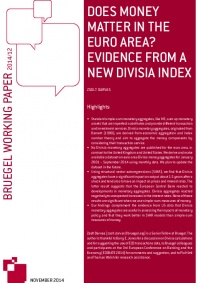Darvas, Ζ. (2014) “Does Money Matter in the Euro area? Evidence from a new Divisia Index“, Bruegel Working Paper 2014/12, 06 November.
The purpose of this paper is to examine the possible role of money shocks on output and prices in the euro area.
Since no Divisia monetary aggregates are available for the euro area, we first create and make available a database on euro-area Divisia monetary aggregates.
We plan to update the dataset in the future and keep it publicly available.
Using different SVAR models, we find sensible and statistically significant responses to Divisia money shocks, while the responses to simple-sum measures of money and interest rates are not statistically significant, and sometimes even the point estimates are not sensible.
Introduction
Measuring the impact of monetary policy on the economy at the zero lower bound is difficult. During the past six years, policy rates were cut close to zero in many advanced countries and central banks implemented various unconventional activities, such as large-scale asset purchase programmes in the United States, United Kingdom and Japan, or long-maturity lending to banks in the euro area. Such unconventional monetary policy measures are not reflected in central bank policy rates and therefore standard structural vector-autoregressions (SVAR) involving the policy rate, such as Christiano, Eichenbaum and Evans (1999), cannot be used in their original forms. At the zero lower bound other indicators of monetary policy are needed. A measure of money may be one such indicator, but measures of money have virtually disappeared from standard monetary models.
Beyond issues related to monetary policy at the zero lower bound, there are other more fundamental reasons for rethinking the design of monetary models and for incorporating a measure of money. One important reason for the disappearance of money from monetary models was empirical: estimated money demand functions were found to be unstable and measures of money proved to be less effective in predicting economic outcomes. However, such empirical failures are challenged by the literature on aggregation-theoretic measurement of money, which was originated by Barnett (1980). The most widely used measures of money, such as M2 and M3 published by central banks, are simple sum measures. Simple sum aggregation implies that all components of the money stock are perfect substitutes, which is a very restrictive and improbable assumption. Correct aggregation can be obtained by using either aggregation theory or statistical index number theory, as first underlined by Barnett (1980), who suggested the discrete-time Törnquist-Theil approximation of the Divisia index (see details in the Appendix).
Recent literature studying US data also underlines the usefulness of Divisia money indicators for monetary analysis. For example, within a cointegrated vector autoregression model, Hendrickson (2013) identifies a stable money demand equation using various measures of Divisia money indices and he also finds that Divisia indicators Granger-cause the growth and level of output as well as the level of prices. The same analysis with simple-sum money indicators led to weaker results. Keating, Kelly and Valcarel (2014) showed that a SVAR model with Divisia money worked as well as the model with the Federal funds rate before the crisis. It worked equally well in the sample that include the period of the zero lower bound when the Federal funds rate model could not be used. Using a different SVAR model, Belongia and Ireland (2014) found support for the inclusion of money in the US monetary policy rule. They also identified money demand and monetary system shocks which led to reasonable output and price responses.
The purpose of this paper is to examine the possible role of money shocks on output and prices in the euro area. Since no Divisia monetary aggregates are available for the euro area, we first create and make available a database on euro-area Divisia monetary aggregates. We plan to update the dataset in the future and keep it publicly available. Using different SVAR models, we find sensible and statistically significant responses to Divisia money shocks, while the responses to simple-sum measures of money and interest rates are not statistically significant, and sometimes even the point estimates are not sensible.
Relevant posts:
- Giavazzi, F. & Tabellini, G. (2014) “What macroeconomic policies for the Eurozone?“, VoxEU Organisation, 25 September.
- Turner, Α. (2014) “Facing Reality in the Eurozone“, Project Syndicate, 08 September.
- Krugman, P. (2013) “The Money Trap“, The New York Times, 14 November.




